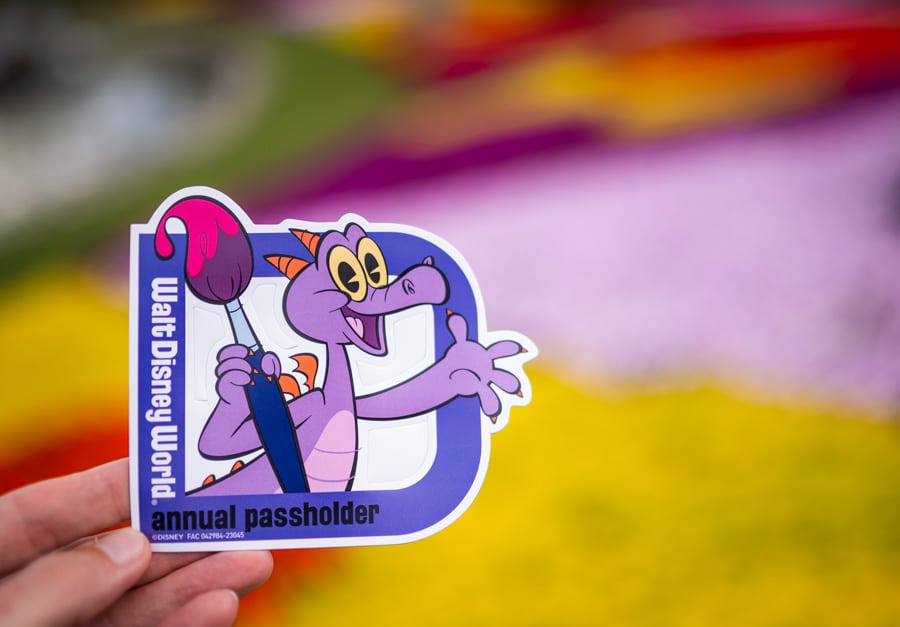

Walt Disney World has lowered the upfront costs for Annual Passes, but increased the monthly payment by a corresponding degree for what amounts to, uh, a price unchange for Florida residents who choose the payment plan. This covers the (non)news about the (un)changed pricing options for APs along with our commentary about why this is actually a big deal. (Not a good deal, but an important move.)
The Florida Resident Monthly Payment Program previously required a down payment of $205. Walt Disney World has dropped this upfront price to only $99. To offset this the reduced down payment, Disney has increased monthly prices, with the result being exactly the same–guests pay the same amount at the end of the 12 months, the allocation of costs just changes.
Monthly Walt Disney World Annual Pass payment amounts are now as follows, with before vs. after amounts:
- Pixie Dust Pass ($469): $34 per month (previously $25)
- Pirate Pass ($829): $65.33 per month (previously $57)
- Sorcerer Pass ($1,079): $88 per month (previously $79)
- Incredi-Pass ($1,549): $130 per month (previously $121)
The Pixie Dust and Pirate Passes are available to only Floridians. The Sorcerer Pass expands eligibility to include Disney Vacation Club members. The top tier Incredi-Pass is the only AP available to the general public. Benefits for all tiers include up to 20% off select dining and merchandise, as well as free standard theme park parking and other perks. Blockout dates and reservation limits apply, and vary by tier.
It’s probably fair to say that the Incredi-Pass offers the worst value for money. I’d imagine that only a single-digit percentage of Floridian Annual Passholders hold that tier. Of Disney Vacation Club members, that number is probably a tad higher, but I’d bet on the Sorcerer Pass being significantly more popular. Judging by crowd patterns, the Pixie Dust Pass is probably far and away the most popular option, overall.


Turning to commentary, this amounts to a price redistribution on a product aimed at Walt Disney World fans in a single state. It probably doesn’t apply to most of you reading this, which may lead you to believe it doesn’t really matter. However, it’s interesting for a few reasons–and I suspect many tourists are overlooking significance of this move since it doesn’t apply to you and won’t cross many of your minds as something that makes a difference. But it does!
The first is that although the price remains unchanged, this is Walt Disney World pulling a “lever” and trying to lure people to the parks. Lowering the upfront cost reduces the barrier of entry for a Walt Disney World Annual Pass, which actually does move the needle on who can afford to visit the parks. Despite the price being unchanged, it’s easier for folks to save up $99 than it is over double that amount.
We’ve had a lot of recent articles about Walt Disney World aiming upmarket. This is the opposite of that.


The Florida Resident Monthly Payment Program may not seem important to out of state tourists used to swallowing $5,000+ vacation costs, but it’s a big deal for many locals who are borderline on being able to afford regular visits to Walt Disney World.
To the best of my knowledge, most APs are sold on payment plans. Lowering the upfront amount makes it easier for residents who are more paycheck to paycheck to buy into a monthly Walt Disney World “subscription.” Each of the individual payments becomes more bite-sized, making it more palatable than even the multi-day resident ticket deals. On the low end, isn’t that much more expensive than Netflix or the Disney Bundle!
(Of course, this is a double-edged sword. Walt Disney World risks more guests stopping payments or exploiting the “loophole” of making the down payment, spending spring break at Walt Disney World, and then stopping payments. Of course, there’s recourse via collections…but that only works if there’s something to collect. This is part of why this option is only open to Floridians in the first place.)


Second, Walt Disney World pulling this lever suggests there’s more to come. It’s been our position that Epic Universe coupled with the continued progression away from pent-up demand is going to force Walt Disney World to get clever. On top of that, the parks and resorts are now seeing higher-spending Canadians cancelling their Florida vacations. There’s reason to believe declining consumer confidence and economic anxiety will result in a tourism downturn in the near future. Several major airlines just cut their forecasts due to soft demand.
Walt Disney World has already pulled from the 2019 playbook for discounts starting last year. Now they’ll need to go a step beyond that into more inventive territory. It’s safe to say this is the beginning of that, and reducing the upfront Annual Pass payment isn’t going to the be the solution in whole.
One of the above factors (Epic Universe or economic uncertainty) would pretty much necessitate as much. A confluence of them, coupled with the lack of new attractions around which to build a marketing campaign, all but guarantees better discounts and special offers.


I wouldn’t be surprised if there are more “levers” that involve Annual Pass promotions. In the past, we’ve seen special offers with bonus months or deeper discounts for DVC members. That’s one option. Another would be making the Sorcerer Pass available to the general public.
Walt Disney World probably doesn’t want to do this, as “forcing” out of state fans to either buy the more expensive multi-day tickets or the top-tier AP is the desired outcome for the company. (We often hear from tourists who are annoyed about Disney’s AP policies, feeling they should be catered to since they spend more–but that’s precisely why they aren’t.)
Of course, this overlooks another possibility: those fans visiting not buying any APs and visiting less. At one point, Disney determined the calculus favored “forcing” more spending or fewer visits. I honestly have no clue whether that’s still an accurate assessment, or if Disney has even thought to revisit the decision.
We might find out soon, though. Annual Pass promos with limited time dollars-off savings or longer durations probably makes the most sense if Walt Disney World wants to do more to bolster their AP base. If I were in charge, I’d make a new ‘Animal Kingdom After 4’ Annual Pass and sell it to anyone.


Along similar lines, Walt Disney World might be doing this because they’ve spotted an opportunity to attract more locals as a hedge ahead of Epic Universe opening. Universal just started selling tickets to Florida residents for Epic Universe…but only pricey multi-day options and vacation packages.
Between the lack of 1-day tickets and Annual Pass add-ons (the latter probably isn’t coming until 2026 at the earliest), this presents an opportunity for Disney to flip the script and attract locals who previously felt alienated by local-unfriendly policies. In other words, it could be the year that many Floridians “sit out” Universal Orlando Annual Passes.
Speaking of Epic Universe, if I were Walt Disney World, I’d be releasing those 4-Park Magic Tickets for Summer and Fall 2025 ASAP. That’s another way to capture attendance (and force people to visit Animal Kingdom!) and pick up the ball that has been dropped by Universal with its glacially slow ticket rollout for Epic Universe.


Finally, one of the most common reactions to the longstanding arguments about Annual Passholders causing overcrowding is the payment plans. This debate predates the phased reopening, park reservations, all that. One of the frequent fan positions has been that Disney should simply eliminate the payment plan if they wanted to reduce overcrowding among APs.
Our consistent response has been that Walt Disney World (and Disneyland, as this is much more common of a topic for West Coasters) doesn’t necessarily want to reduce the number of Annual Passholders. What they want is more granular control. This is why Magic Key sales use a Disney Vault strategy and reservations are required.
It’s the same idea with crowds, period. Disney doesn’t want lower attendance. If they could maximize guest spending & satisfaction, and crowds, they absolutely would. Hence the wait times we see between Christmas and New Year’s Eve, which is both the busiest week of the entire year and the most expensive.
That approach isn’t replicable most weeks, but that example should be proof positive that Disney wants to have its cake and eat it, too. Since that isn’t realistic most of the year, they instead optimize for spending, satisfaction, and crowds. Controlling the flow of Annual Passholders is one such way, opening that valve a little more–like right now–when tourist numbers are down (or projected to be down).


Hence that infamous comment from Disney’s dearly-departed former CFO a few years back about the “unfavorable attendance mix” at Disneyland. Diehard fans immediately pounced on this, taking both personal offense and brandishing the term as a rallying cry. To this day, we still spot shirts that reference this remark and refer to the wearer as an “unfavorable.” It’s a weird move that’s going to be lost on 98% of guests who see them, but to each their own.
While I agree with the underlying sentiment that executives should choose their words more carefully, guest spending numbers are what they are. Statistically, Annual Passholders spend less per visit than tourists and other demos. I truly don’t get why anyone cares. I’m part of the “unfavorable” demo, and this doesn’t bother me in the least. If anything, you should wear the title as a badge of honor–you’re more frugal than the average tourist and more discerning about how much money you give to Disney!
Planning a Walt Disney World trip? Learn about hotels on our Walt Disney World Hotels Reviews page. For where to eat, read our Walt Disney World Restaurant Reviews. To save money on tickets or determine which type to buy, read our Tips for Saving Money on Walt Disney World Tickets post. Our What to Pack for Disney Trips post takes a unique look at clever items to take. For what to do and when to do it, our Walt Disney World Ride Guides will help. For comprehensive advice, the best place to start is our Walt Disney World Trip Planning Guide for everything you need to know!
YOUR THOUGHTS
What do you think of Walt Disney World reducing the upfront payment for Annual Passes as part of the Florida Resident Monthly Payment Program? Think this reduced barrier to entry will move the needle on AP sales among locals? Wish WDW would do more to incentivize Annual Pass purchases among out of state fans? Any expectations about special offers going forward? Do you agree or disagree with our assessment? Any questions we can help you answer? Hearing your feedback–even when you disagree with us–is both interesting to us and helpful to other readers, so please share your thoughts below in the comments!

